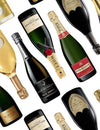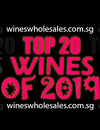
ALL CHAMPAGNE IS SPARKLING WINE, BUT NOT ALL SPARKLING WINE IS CHAMPAGNE
We should think of Champagne in terms of a geographical place. A Sparkling wine can only be called Champagne if it comes from the region of Champagne, France. Further, Champagne can only be made using Chardonnay, Pinot Noir, and Pinot Meunier and must be made in the Méthode Traditionelle (Bottle Fermentation).
WHY ARE CHAMPAGNE EXPENSIVE?
As mentioned, a sparkling wine can only be called Champagne if grown and produced in a relatively small area of northeastern France. Within the Champagne region, only certain places are of quality vineyards which makes the supply in great demand.
Over the years, extensive marketing has also helped bolster the notion that Champagne is the prestige beverage of quality for celebrations. Of course, the Champagne region’s combination of climate and soil conditions indeed give the wine its unique and desirable characteristics.
That being said, there are also other French sparkling wines made using the same “Méthode Traditionnelle” of secondary bottle fermentation, which delivers much of which Champagne offers, but at half the price or less.

THEY MAY NOT BE CHAMPAGNE BUT THEY ARE GOOD BUBBLES
Sparkling wine is made in all of France’s major wine regions, with Loire, Alsace, Burgundy and the Languedoc area of Limoux producing the best.
Sparkling wines are also produced in just about every country that makes wine, and they vary in tastes, quality levels, and prices. In Italy, Prosecco is the sparkling wine made in Veneto region from Glera grapes. Franciacorta, on the other hand, use the same Champagne Traditional Method with Chardonnay, Pinot Noir and Pinot Blanc grapes. Prosecco tends to be more bubbly, fruitier and fresher than its Franciacorta counterpart which is more complex.
Cava is Spain’s most popular sparkling wine made in the same way as Champagne and arguably some of the best values in sparkling wine today. Almost 95 percent of Spanish Cava is produced in Catalonia of northeastern Spain and is made from Macabeu, Parellada and Xarello grapes.
In Germany the term Sekt is used for sparkling wine, which mostly uses the charmat method for seconday fermentation, similar to prosecco. The term Deutscher Sekt (German sparkling wine) indicate the grapes must originate 100% from Germany otherwise not allowed to bear the name of a specified region on the label.
Regardless, there is always a good reason to drinking bubbles- be it celebrating a birthday, toasting the start of a new career or just fancy treating yourself. While we are spoilt for choices from dry to sweet sparkling wines, it all goes down to what suits best for your occasion and budget.

GUIDE TO SPARKLING WINE STYLE
Brut – A dry sparkling wine, containing very little sweetness. This is the most popular kind of sparkling wine; typically enjoyed before or during meals.
Demi-sec - A sweet style of champagne.
Extra Brut – The driest style of sparkling wine containing little, if any, sugar. If no sugar at all has been added, it may be labeled Brut Nature.
Extra dry – Despite the name, a sparkling wine labeled extra dry is actually slightly sweeter than a wine labeled brut.
Sec – Although in French it means “dry,” a sparkling wine labeled sec is semisweet.
GUIDE TO SPARKLING WINE TERMS
Blanc de Blanc - Sparkling wines made exclusively with white grapes. In the case of Champagne, this means the wine has been made with 100% Chardonnay grapes.
Blanc de Noir – Sparkling wines made exclusively with red grapes, either 100% Pinot Noir or a blend of Pinot Noir and Pinot Meunier.
Méthode Traditionnelle:- The traditional method of creating sparkling wine, where a second fermentation occurs in the bottle, creating bubbles.
Non-vintage – when grapes blended from more than one harvest are used to make Champagne it is called non-vintage, or NV.
Vintage – when grapes made from the harvest of a single year are used to make Champagne it is called “Vintage.” The year appears on the label of the bottle of Vintage Champagnes

Leave a comment
















